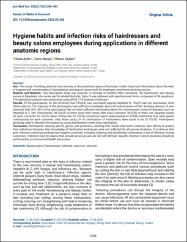| dc.contributor.author | Aydın, Suna | |
| dc.contributor.author | Aksoy, Aziz | |
| dc.contributor.author | Ceylan, Hacer | |
| dc.date.accessioned | 2021-05-28T09:21:01Z | |
| dc.date.available | 2021-05-28T09:21:01Z | |
| dc.date.issued | 2020 | en_US |
| dc.identifier.citation | Aydin, S., Aksoy, A., & Ceylan, H. (January 01, 2020). Hygiene habits and infection risks of hairdressers and beauty salons employees during applications in different anatomic regions. Annals of Medical Research, 27, 9, 2396. | en_US |
| dc.identifier.issn | 2636-7688 | en_US |
| dc.identifier.issn | 2636-7688 | en_US |
| dc.identifier.uri | https://doi.org/10.5455/annalsmedres.2020.05.438 | |
| dc.identifier.uri | https://hdl.handle.net/20.500.12899/155 | |
| dc.description.abstract | Aim: This study; Providing personal care services to the anatomical parts of the body, it offers important information about the risks of hygiene and contamination in hairdressers and beauty salons both for employees and those receiving service. Material and Methods: This descriptive study was planned; It consists of 60(46F+14M) volunteers. 26 hairdressers and beauty salons in Diyarbakır city center and its related districts. Data; It was obtained with questionnaire forms composed of 84 questions. The statistical analyses were performed using SPSS 17.0 Statistics Software. Results: Of the participants, he did not know that 73%(44) was vaccinated against hepatitis B, 15%(9) was not vaccinated, while others did not. The majority of the participants had sufficient knowledge about the transmission of hair-breaking disease. It was observed that 20%-30% of the participants did not have sufficient information about the transmission routes of diseases such as Hepatitis B, C, HIV. Participants; 38.3%(23) of them wash their hands after each customer, 50%(30) of them use separate towels for each customer, 51.7%(31) when cutting hair, 41.7%(25) continuous apron while waxing 63.3%(38) stated that they wear gloves continuously for each customer. Only those using UV for sterilization of instruments were found to be 26.7%(16). Participants generally used to disinfect the bottom by using disinfectants rather than sterilization. Conclusion: Participants' wearing aprons, gloves and protectors, washing their hands after each customer, their efforts to protect from infectious diseases, their knowledge of sterilization techniques were not sufficient for all service locations. It is obvious that poor infection control procedures and hygienic practices, including cleaning and disinfection, will present a risk of infection among customers. Infection risks for places that provide personal care are not well defined. Specific infection control practices should be performed by environmental health physicians. | en_US |
| dc.language.iso | en | en_US |
| dc.publisher | İnönü Üniversitesi | en_US |
| dc.relation.ispartof | Annals of Medical Research = (Ann Med Res) | en_US |
| dc.rights | info:eu-repo/semantics/openAccess | en_US |
| dc.subject | Beauty salons | en_US |
| dc.subject | Hairdressers | en_US |
| dc.subject | İnfected | en_US |
| dc.subject | Manicure | en_US |
| dc.subject | Skincare | en_US |
| dc.title | Hygiene habits and infection risks of hairdressers and beauty salons employees during applications in different anatomic regions | en_US |
| dc.type | Article | en_US |
| dc.authorid | 0000-0002-9683-6691 | en_US |
| dc.department | MTÖ Üniversitesi, Mühendislik ve Doğa Bilimleri Fakültesi, Biyomühendislik Bölümü | en_US |
| dc.institutionauthor | Aksoy, Aziz | |
| dc.identifier.doi | 10.5455/annalsmedres.2020.05.438 | |
| dc.identifier.volume | 27 | en_US |
| dc.identifier.issue | 9 | en_US |
| dc.identifier.startpage | 2396 | en_US |
| dc.identifier.endpage | 2403 | en_US |
| dc.relation.publicationcategory | Makale - Ulusal Hakemli Dergi - Kurum Öğretim Elemanı | en_US |
| dc.indekslendigikaynak | TR-Dizin | en_US |


















